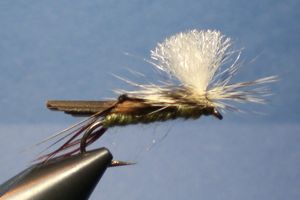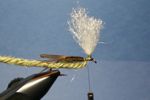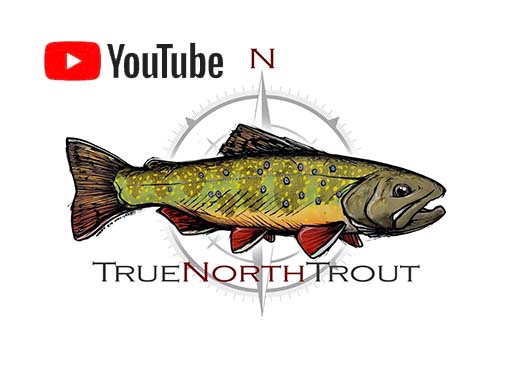
The Parahopper
When I think of hopper fishing, I tend to picture a certain set of “ideal” conditions in my head: a stream with moderate to fast current flowing through a wide-open meadow full of tall grass that overhangs the stream banks on a warm summer afternoon, with occasional gusting winds to knock the hoppers into the water where the trout are waiting for them…maybe a couple of cows grazing in the meadow for that look of pastoral splendor…something like that.
The Madam X, featured in last week’s installment, is an ideal pattern for such conditions, as it is designed to simply give the impression of movement—fluttering wings, flailing legs, etc.—when viewed through a lens of fast, choppy water.
What happens, though, when the trout are in calm, clear water, and there isn’t enough wind to ruffle the surface, but there are still hoppers about? From a fish’s point of view, when a hopper falls onto the water’s surface in these conditions, it no longer appears as just a blur of motion, but an actual insect with some very distinct parts—an elongated body that rides flush in the surface film, a flat wing folded tent-style over the body and, perhaps most notably, two very long, distinctly jointed legs. In this situation a bushy attractor pattern like the Madam X will usually draw a refusal, and will sometimes actually put the fish down.
When conditions demand a more realistic imitation, I reach for a Parachute Hopper. There certainly are some snazzier patterns in the fly shop bins that may look more like the real thing to a fisherman, but I like the simple Parachute Hopper because it accurately represents those features of the natural insect that are most prominent to a fish gazing up through the water column (body, wing profile, and rear legs).
My version of the fly is a very slight variation on the well-known Rainy’s Parachute Hopper. Where the original pattern calls for calf tail hair for the upright wing “post”, I use instead a synthetic material called Hi-Vis. It mounts much more easily than the bulky, slippery calf tail, and it is exponentially easier to handle when winding the parachute hackle.
The only potentially difficult part of the Parachute Hopper is the jointed legs, which are created by tying a knot in a small bunch of pheasant tail fibers. You can do this by hand, or you can save lots of time and possibly your sanity by either purchasing one of the specialty tools (such as Rainy’s E-Z Hopper Leg Tool) that are made just for this application, or by simply using the pre-knotted legs that are available from many fly shops and online retailers.
Many fly tiers complain that it is difficult to keep the legs from splaying out to the sides when they are mounted. I have an easy solution to this problem: let them. The neat upright legs so often seen in photos of this pattern look right to us because that’s how we most often see real hoppers: with their rear legs poised to jump. When a natural hopper falls into the water, however, its powerful “hopping legs” kick and flail out to its sides as it tries to right its body on the surface and/or swim to safety, so why not let your fly’s legs imitate what the trout actually see?
The Parahopper
Hook: Standard dry fly, size 8
Thread: 6/0 tying thread, color to match
Body: Synthetic yarn
Wing: Mottled turkey
Legs: 4 to 5 pheasant tail fibers (or prepared legs)
Wing Post: Hi-Viz (or similar)
Hackle: Grizzly
This simple but effective fly can be tied in any combination of colors you choose—I recommend catching a couple of the naturals living along the banks of your favorite stream and taking them home to copy at the bench. Carry a few in your terrestrial box for those times when trout disdain the flashier attractor patterns, but you know they still want a hopper. You won’t be disappointed.
Tying the Parachute Hopper
- Tie-in 6/0 tying thread, and then tie-in yarn at the hook bend. Advance thread 2/3 of the way up the shank, then cover the rear 2/3 of the shank with yarn and tie-off material to form an attractive segmented body. Do not cut yarn.
- Cut a segment that is equal in width to the hook gap from a turkey tail feather that has been prepared with cement or spray fixative. Trim the end of the segment to a rounded point, and tie-in the segment by its other end.

Step #3
- Prepare the hopper’s legs with an appropriate tool. Or select and prepare the purchased legs in order to make an appropriate set. Or drive yourself absolutely mad by making your own. In any event, tie-in one leg on either side of the body.Don’t get all worked-up about it if it isn’t absolutely perfect as the fish do not care.
- Cover wing and leg butts with yarn. This will give the fly a nice, finished look.
- Tie-in a length of synthetic wing post material on top of the shank. Tug the ends of the material until perpendicular to the shank; secure in this position using “x” wraps.

Step #6
- Tug the ends of the post material straight up above the shank. Take several turns of thread around their base, just above the shank, effectively combining the two ends into a solid wing post.
- Select and prepare an appropriate grizzly hackle for the purposes of tying a parachute collar. Tie-in the grizzly hackle feather at the base of the wing post.
- Wrap yarn to just in front of the wing post. Secure yarn and trim the tag end.
- Wrap the hackle counterclockwise around the wing post, starting at the top of the thread wraps securing the post and wrapping downward to the hook shank. Tie-off and trim the hackle.
- Make a neat thread head. Secure with whip finish and head cement.

